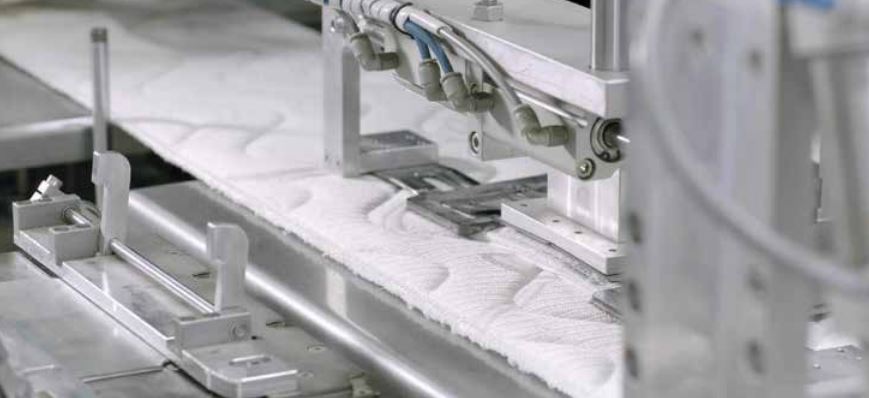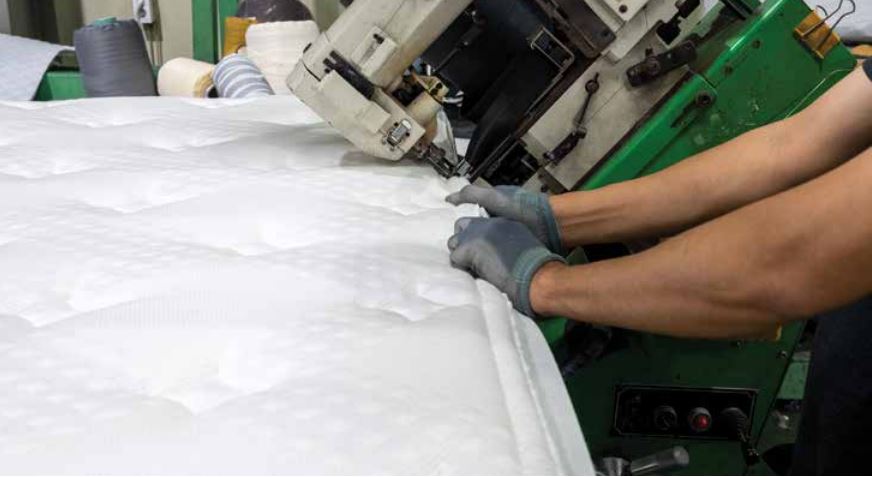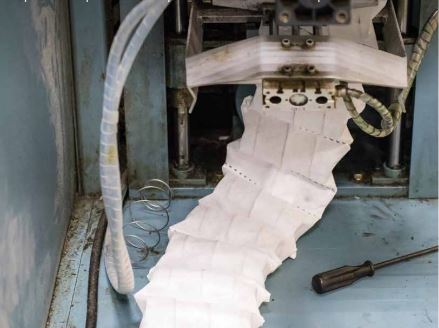Automation in mattress production offers numerous advantages to the manufacturer, however, mattress factories in India are yet to be fully automated. Before considering automation, manufacturers must assess their volume of production as automation needs substantial capital investment. Meanwhile, mattress manufacturers can streamline and optimize their information flow, which will have a positive impact on their upstream and downstream processes…
The Indian mattress industry is on its growth trajectory with the organized segment recording steady growth. In our last issue, we analyzed how the organized segment is stealing its share from its unorganized peers. Meanwhile, consumers are showing more inclination towards good quality sleep products due to increased understanding about the benefits of good sleep towards ensuring overall well-being, higher disposable income and need for a better standard of living. The mattress industry in India is growing and with the ingress of new players in the market with their new ideas, the sleep industry is growing bigger. The introduction of the D2C model has increased the accessibility of good quality sleep products at a reasonable price. Coupled with that, the easy buying and return policies and 100-day trial initiatives by various mattress companies have lured many consumers towards good quality mattresses and sleep products from organized players in the mattress industry.
Now, with the growing demand for good quality mattresses, manufacturers have to roll up their sleeves to meet the growing requirements of consumers. For this reason, increased adoption of an automated environment in mattress manufacturing firms is now more important than before. Automation is not a new concept in the manufacturing industry. It helps manufacturing concerns get production processes faster, better and more efficient by eliminating the risk of human errors. The growing number of mattress manufacturers in India have invested a good amount of resources in automated machines so that they can use their skilled labour towards more constructive activities like ensuring better quality checks and strict adherence towards sustainable measures.
“Most of the mattress factories earlier were manually operated. Now, automation is more of a necessity as it helps improving efficiency, productivity, reduces chances of errors and most importantly, it is economic,” says S Sundaresan, Secretary, Indian Sleep Products Federation (ISPF).
Additionally, a well-automated mattress manufacturing facility will help reduce production waste and ensure the safety of factory workers. Mattress manufacturing happens in multiple phases, right from raw material procurement to final packaging.
“In the traditional mattresses, around 30 to 40 percent of the portion has been automated in terms of pasting and lamination of the mattresses. So, the finish of the mattresses was always automatic since beginning but still there is some manual component involved in the traditional mattresses which I do not think will go very early,” says Himanshu Mehta, Managing Director at Himrag Coir Products Private Limited.
Though the mattress manufacturing business looks positive there are many concerns that the manufacturers must consider while increasing the adoption of automation in their manufacturing facilities. This article will explore further the need for automation, the ideal processes for implementing an automated environment in mattress factories and the biggest challenge facing manufacturers while considering automation.
Increased adoption of an automated environment in the mattress manufacturing firms is now more important than before.
Need for automation
Automation is important in mattress manufacturing as it ensures operational efficiency, optimum time savings, flexibility and scalability and better return on investment (ROI). It is now a valuable consideration due to factors like the unavailability of skilled labourers, changing and competitive business models and shrinking profit margins. Investing in automation in mattress manufacturing will make the industry more productive and profitable. Automation can help mattress manufacturers in terms of
- Saving Time and Money
- Boosts productivity by delivering finished products in less time
- Ensures a better work environment by ensuring hygiene and safety for workers
- Ensure product quality as machines are less prone to errors
- Enhances competence by standardizing workflows
- Flexibility to manufacture different mattress models
Now, the big question is, where do Indian mattress makers stand in terms of embracing automation? Sreedher Kadambi, Managing Director of SKIL Global Business Solutions says, “There are some companies that are having reasonable level of automation in the industry while there are some who don’t have so much of automation today. In my opinion, the level of automation in the mattress industry can be a lot better than what it is today.”
Manufacturers must adopt a holistic approach towards automating their manufacturing facilities. The established mattress suppliers are evaluating every non-value step in their supply chain operations that can be automated and the relatively new players should start early and have a comprehensive plan for automating every possible step in the supply chain that could streamline daily business operations.
Automation in Indian Mattress Industry
Before embracing automation, one needs to understand the real objective of embracing automation. Mattress manufacturers should not restrict their ideas on automation by getting highly mechanized machines. That is just a part of the solution towards automating the manufacturing facility.
According to Kadambi, there are two areas in a manufacturing facility that need automation, i.e. the information and the manufacturing area. Automation can do wonders in both the manufacturing and information areas. Information is what drives manufacturing. Without information or a proper plan of action, it isn’t easy to attain efficiency in production processes. Meanwhile, without proper communication between procurement and suppliers, there will not be raw materials. Additionally, without adequate and accurate information flow, in the upstream processes, the downstream processes will only suffer.
Manufacturers must consider streamlining and optimizing the information flow in the upstream processes. An appropriate process describing the information flow right from customer order to the time you start producing the customer order, its adequacy, and accuracy must be outlined. Meanwhile, it also must be established whether information flow is happening between the right set of people at the right time. The information transferred should be adequate, accurate and on time. “Now this part is a largely neglected area of automation, wherein, say information flow is usually taken for granted in industries in manufacturing and a lot of issues that you see in the downstream process is the consequence of poor information flow in the upstream process,” explains Kadambi.
Lot of issues and problems you face in the production of mattresses that could relate to how well the information was researched, transmitted and archived. That is the first part, which is the most neglected part of the industry. So, one must look at how AI or automation or any suitable means of automation is potentially streamlined and optimized. How the information flows between various business processes and the steps within those processes from upstream to downstream. That’s one significant area where information automation should play a significant role.
Now, once the information area is established, the production or manufacturing side should pull our attention. It has often been noticed that some manufacturing units run smoothly and the routine jobs are largely carried out in order, whereas, many units are always in a state of chaos and confusion. This chaos or bad management on the manufacturing floor is most likely to occur due to poor design of the process and poor process capabilities. Due to poor design and process capabilities, it has been realized that production has not met the delivery dates, has not achieved the desired quality and also failed to achieve the targeted costs. So, automation should be perceived in the downstream process as well, to enhance productivity, efficiency, and quality and therefore reduce your cost of goods sold (COGS).

A well automated mattress manufacturing facility will help reduce production waste and ensure safety of factory workers.
Having a comprehensive plan of production processes will enable mattress manufacturers to have full control over the overall production. Meanwhile, it will help manufacturers streamline the entire production process and expect a better return on their investment (ROI). Additionally, it will give them better scope to expand their operations as they can utilize their resources most effectively through automation. Mattress Manufacturers should also think meticulously when it comes to evaluating automation in their manufacturing units.
Through automation, mattress manufacturers can also ensure better ‘inventory management’. Various raw materials go into making a mattress and keeping a watch on the stock of these raw materials will help mattress manufacturers efficiently utilize their resources. And once the final product comes out of the entire production line, it is important to ensure that it goes to the market.
Another area, where automation could help is to ‘predict and forecast’ the demand for the product. What will be the order volumes in the present, future and long term? An automated tool that considers the market trends or market consumption pattern or a company’s sales pattern etc. and tells them to some level of precision, what they need to stock and how much they need to stock up each of them. That will have a direct impact on their cash pile in the form of inventory. “Inventory does not pay off by itself. It’s the money trapped in the system,” explains Kadambi of Skill Global Business Solutions.
As the mattress industry is getting more competitive, mattress brands must ensure that their products are available at their exclusive retail outlets and in multi-brand outlets. They should be available on the shelves so that the customer gets limited scope to try the other brands available alongside. Situations like these are easier to avoid if mattress suppliers use automation to predict and forecast their monthly, quarterly and, annual production. With any automated application, mattress manufacturers can get a fair idea about their adequate requirements, which will, in turn, help them gear up their entire supply chain operations. Meanwhile, automation will also provide them with a good estimate of consumer demand for any particular product at a given point in time. This will help them decide on the right production model, for instance, mass production, batch production, job production, just-in-time production or a flexible manufacturing system. If required, manufacturers can also adopt a combination of some of the models to suit their demand and supply requirements
Investing in automation in mattress manufacturing will make the industry more productive and profitable.
All this key information related to the demand and supply of mattresses, inventory availability, and time to reach the market can be presented in a unified format through automation. “From the first step to the last step of manufacturing, what do companies need to produce and how much of it they need to produce has to be reasonably automated while it reaches them before it reaches them. So that, they are not wondering what are they going to produce tomorrow or the day after. On the other hand, they are not guessing, if there is going to be change over etc. So, the impact of automation is huge on manufacturing,” explains Kadambi.
According to Kadambi, another area where automation could help ensure better efficiency by saving time and energy is having some mechanized systems that could move and transport material from one place to another place, thereby, minimizing the effort and the timing, because effort and time come as a cost. “Stage by stage, organizations have to consider what steps they undertake till the time, raw material converts into finished goods, which either goes into a warehouse or it goes to the customer directly. Every non-value added step that one incurs in manufacturing on a stage-to-stage basis is a potential candidate to evaluate for automation,” says Kadambi.

Manufacturers must adopt a holistic approach towards automating their manufacturing facilities.
Embracing Automation: Challenges faced by mattress manufacturers
Automation in the mattress industry is more of a need than an innovative approach. While embracing automation, manufacturers need to assess how much automation they need for their daily production. Meanwhile, do they need to automate their manufacturing facility? It depends on the volume of business and the cost-to-benefit ratio. Vijay Palanna, Director of Empulse Research And Data Analytics (India) Private Limited says that automation works well for bigger and established mattress manufacturers rather than the new players who are yet to build up that consumer base. “Automation brings numerous advantages like efficiency, standardization, and quality control, to name a few. However one needs to do a cost-benefit analysis. Automation requires capital investment, so it works well for large manufacturers who have the volumes but it may not be the right decision for small players” explains Palanna.
Meanwhile, there are other intermittent issues that manufacturers may encounter in terms of equipment failure, technical snags or power shutdown.
Conclusion
Mattress manufacturers in India had embraced automation a long time back and the need for automation is only going to increase with the growing demand for mattresses across the country. Automation is becoming a necessity among long-visioned mattress manufacturers as it is required to maintain good quality mattresses. Manufacturers can vouch for automation for its speed, efficiency and minimum chances for errors. As it saves time, it allows manufacturers to scale their production. For instance, if earlier manual labourers could pack 20 bundles in an hour, now with automation, nearly 60 to 80 bundles can be packed. Automation can also help to a great extent in managing the logistics of mattresses. Mattresses can be loaded onto a truck or delivery van through a conveyor belt, thereby, saving a substantial amount of time. For large-scale manufacturers, automation works out to be economic while ensuring other advantages like time and cost efficiency, and error-free operations.
While in traditional mattresses, only 30 to 40 percent of the processes are automated, in new mattress models like ‘bed-in-a-box’ are manufactured in a completely automated environment. As the mattress industry is coming up with newer concepts and manufacturers are looking at tapping the unexplored markets, our mattress factories will have to resort to a completely automated environment.


